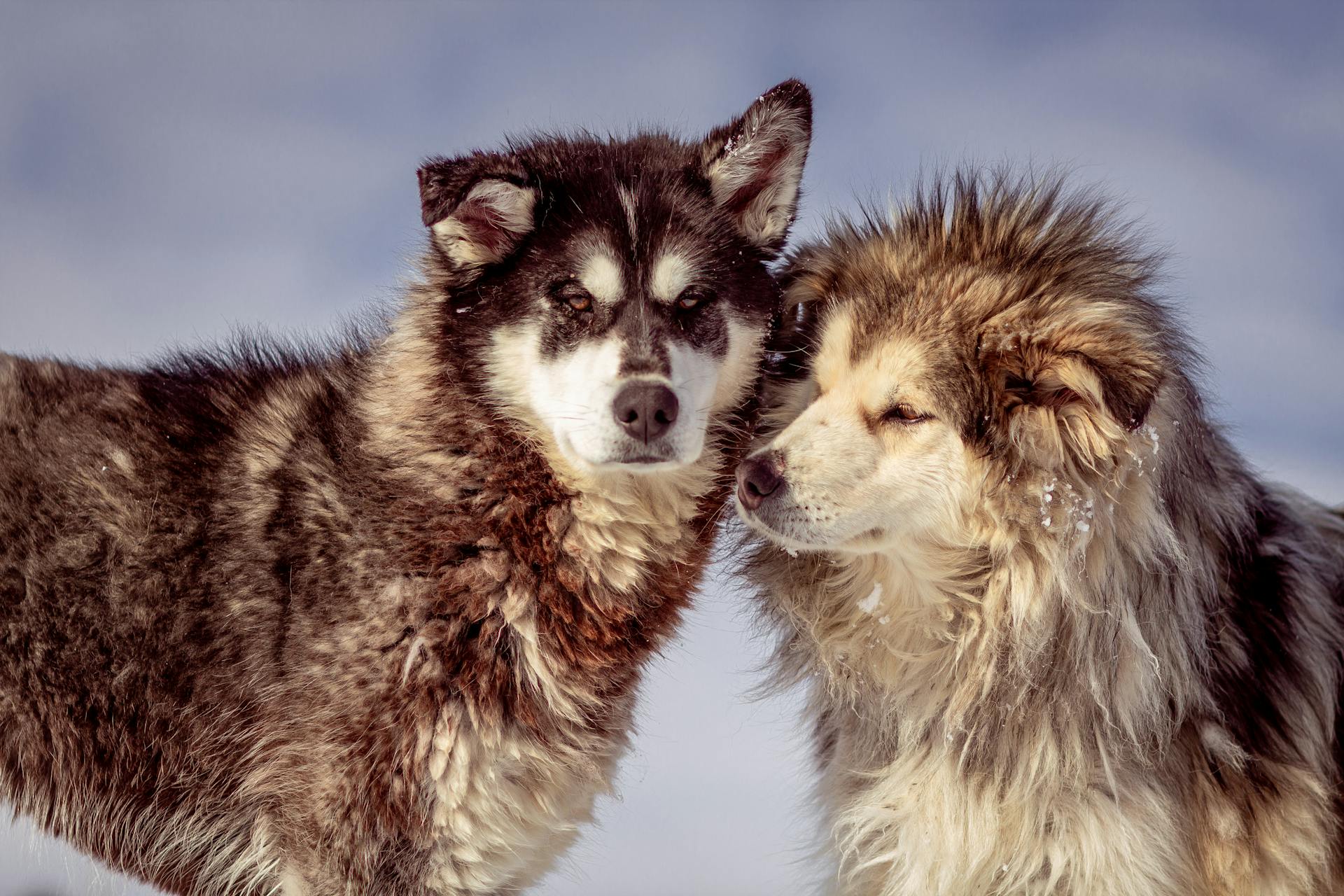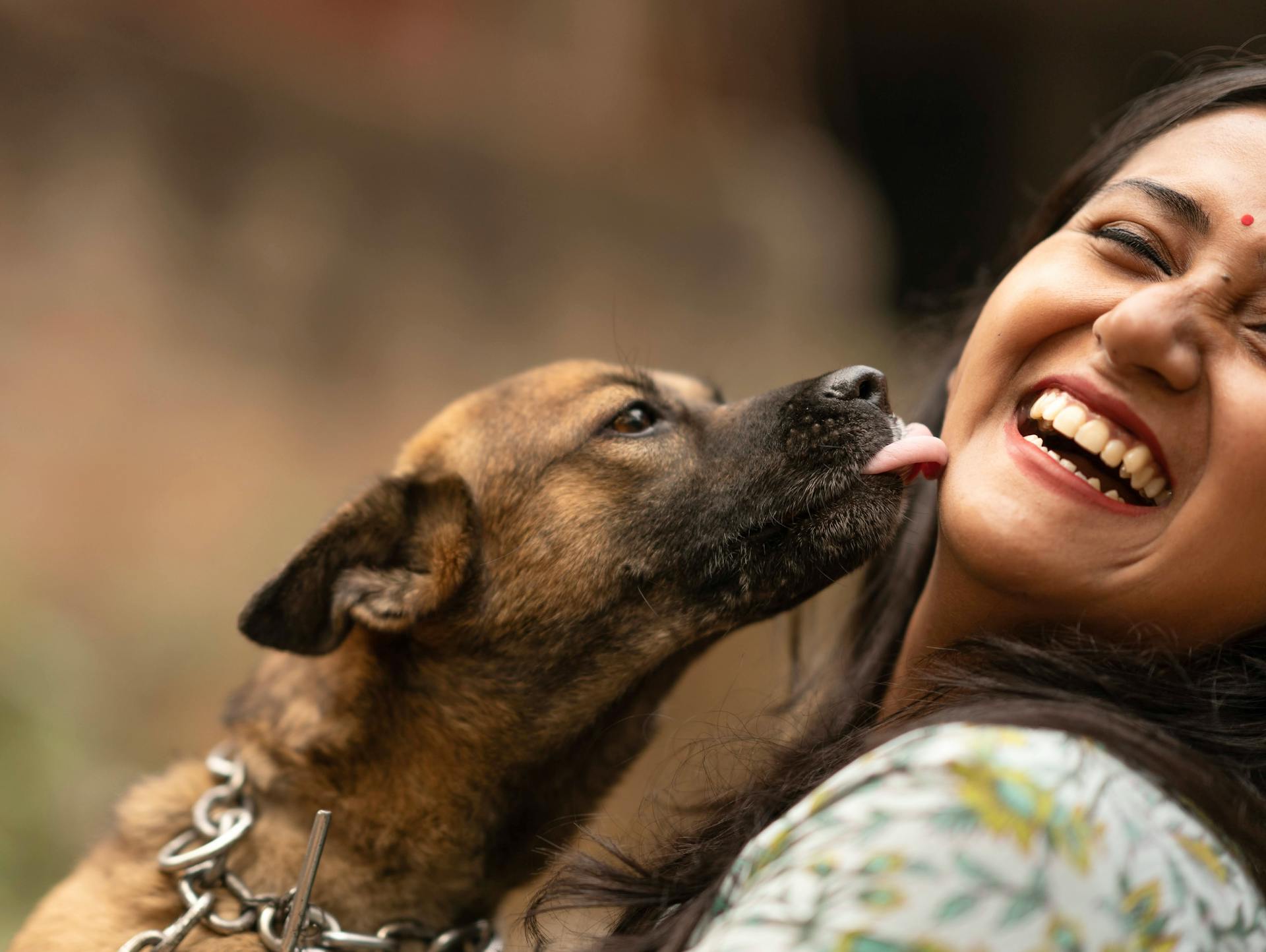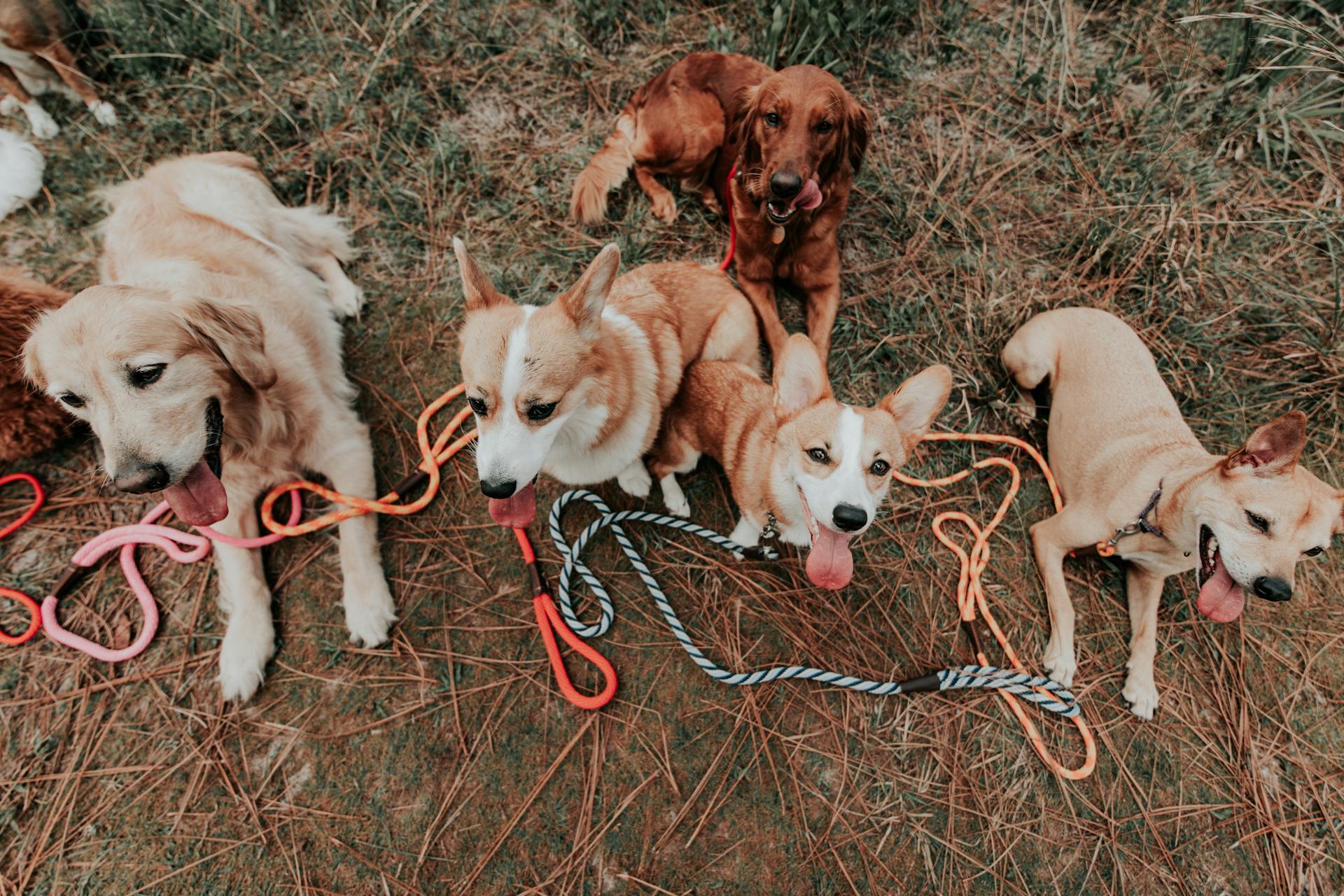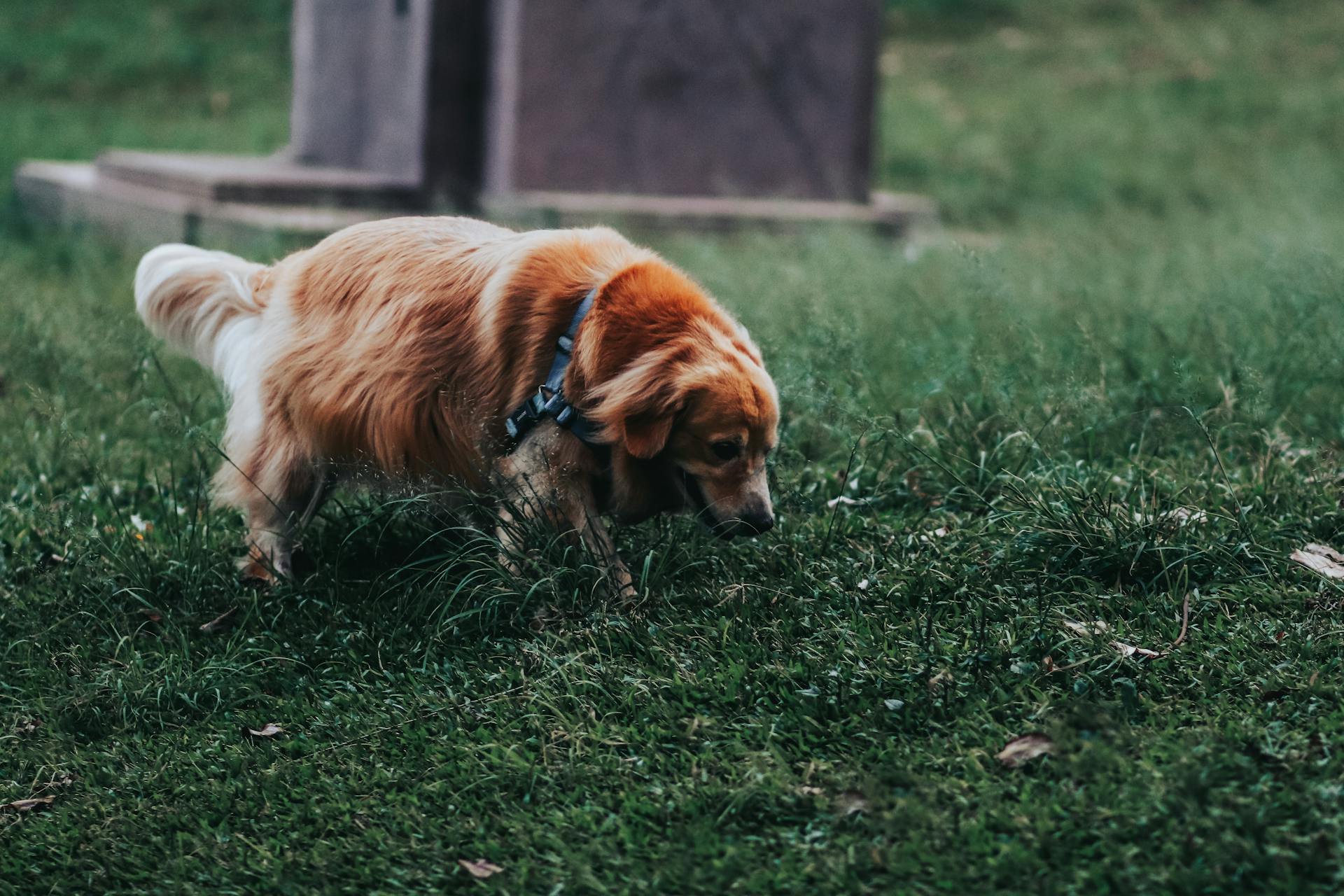
Canine mating behavior is a complex and fascinating topic. Mating typically occurs between 6 to 12 months of age, when the female is in heat for the first time.
Female dogs in heat can be receptive to males for 2-3 weeks, with the fertile period lasting only 3-5 days. This short window makes timing crucial for successful breeding.
A male dog's ability to mate with a female in heat is influenced by his age, with younger males often being more fertile. Males can mate multiple times during the female's fertile period.
Female dogs usually give birth to 1-12 puppies, with an average litter size of 5-6 puppies.
Recommended read: Signs a Female Dog Has Mated
Canine Mating Behavior
Female dogs typically come into heat for the first time between 6 to 12 months of age, with smaller dogs maturing earlier than larger dogs.
During this time, they release pheromones that signal their fertility status to male dogs, which have a highly developed sense of smell to detect these chemical signals.
Female dogs in heat will often exhibit proceptive behavior, such as interest in male dogs and flirtation with them, accompanied by vulval swelling and some bleeding.
If males try to mount a female dog in proestrus, she will often rebuff their efforts by turning and growling or snapping.
Female dogs usually come into heat cyclically and are receptive and fertile between one and four times per year, with an average of two heats annually.
Male dogs typically reach their first peak of testosterone levels at around 5 months of age, which can lead to mounting and thrusting behavior.
By 7 months, male dogs may seek to mate, attracted by pheromones put off by female dogs in heat.
Mating usually occurs for the first time when the male dog is around one year of age.
You might enjoy: When Do Rottweilers Go into Heat
Preparation and Safety
Before you start the mating process, it's essential to make sure both dogs are in top physical condition. Both dogs should be screened for any relevant health tests and be on a quality dog food with regular exercise.
Make sure to check with your vet before mating, as they can provide valuable advice and ensure both dogs are healthy enough for breeding.
Female dogs can become pregnant as early as 6 months old, but responsible breeders will wait until they're physically and mentally mature enough to cope with having puppies.
To help a dog mate, it's best to match an inexperienced dog with one that has more experience, as this can help prevent problems.
Male dogs tend to be more stressed by mating, so it's usually best to take the female dog to the male's environment for breeding.
Here are some essential tips to keep in mind when introducing the dogs to each other:
- Keep them on the lead while they get used to each other
- Let them off lead once they seem comfortable around each other
- Try to keep things quiet and calm
- Minimize the number of people and other animals present
Mating the dogs 2 to 3 times, usually 1 to 2 days after the first mating, can make the pregnancy more likely.
Related reading: Female Dog after Mating
Mating Process
Dogs mate by sniffing at the female's rear end to detect pheromones indicating fertility.
The female may respond by moving her tail to one side, known as 'flagging', which signals her readiness to mate.
A stud dog will then mount the female and position himself with his front legs on either side of her midsection for stability.
It may take several attempts for the stud dog to successfully enter the female, but most dogs can manage this on their own.
Once in position, the stud dog will insert his penis into the female's vagina and begin to thrust.
After ejaculation, the two dogs may become physically locked together in a 'breeding tie', a natural part of the mating process.
Health and Well-being
A dog's health and well-being can be significantly impacted by their mating behavior.
Dogs that are not spayed or neutered may be more prone to certain health issues, such as uterine infections and testicular cancer.
A well-balanced diet and regular exercise can help support a dog's overall health and well-being, regardless of their mating status.
If this caught your attention, see: Male Dogs Mating
Hormonal Fluctuations

Hormonal fluctuations play a significant role in a dog's reproductive behavior. Testosterone levels rise during the mating season, making male dogs more receptive to pheromones released by females in estrus.
Male dogs often mark their surroundings with urine to communicate their presence to potential mates and competitors. This behavior is particularly heightened during the mating season.
A vaginal smear test can be used to check when a dog is most fertile, as it can detect specific cell changes that suggest ovulation. This test is reasonably reliable and non-invasive.
Blood tests can also measure hormone levels to determine when a dog is most fertile. Vets may check progesterone levels or LH (luteinizing hormone) to accurately find the optimal breeding time.
A bitch may not be keen to mate due to various reasons, but understanding hormonal fluctuations can help breeders make informed decisions.
Worth a look: Canine Distemper Test
Minimum Mating Age
Male dogs can technically mate as soon as they've become sexually mature, but it's often recommended to wait until they're a little older before using them for breeding.
Many breeds have health tests and screening schemes that require dogs to be at least 1 year old, such as the hip and elbow dysplasia schemes.
Responsible breeders will wait until their female dog is physically and mentally mature enough to cope with having puppies, which can be from as early as 6 months old depending on their size and breed.
It's usually recommended to wait until female dogs have had several seasons before deciding whether to breed from them.
In some breeds, we recommend waiting until the dogs are old enough to be screened for certain health conditions before deciding whether to breed from them.
Take a look at this: When to Breed a Female Dog in Heat
Getting Stuck
Getting stuck during mating is a common phenomenon in dogs, wolves, and foxes, and it's often seen as a sign of a successful mating.
A breeding tie occurs when the gland at the end of the male's penis swells up and is gripped by the contracting muscles of the female's vagina, preventing the two from being separated.

The stud dog may turn himself by lifting one leg over the female's back to ensure they're both secure and comfortable in a back-to-back position.
Trying to force two tied dogs apart can be painful and may even damage their genitals, so it's essential to let them separate naturally.
The stud dog will naturally separate from the female when his penis becomes less swollen, and this usually happens without any intervention.
Tests for Fertility
Tests for Fertility can be a bit tricky, but understanding them can make all the difference in getting your dog pregnant. It's essential to know when your dog is most fertile to increase the chances of a successful mating.
Your vet can perform two simple tests to help you determine when your dog is most fertile. The vaginal smear test, also known as vaginal cytology, is a non-invasive test that involves taking swabs from your dog's vagina and examining the cells under a microscope.
Discover more: When Do Male Dogs Start Producing Sperm

A blood test can also be used to measure your dog's hormone levels, which change as she goes through her season. Your vet can check for LH (luteinizing hormone) or progesterone levels to accurately find when she's most fertile.
Dogs usually reach their peak fertility between days 10 and 14 of their season, although this can vary. Some dogs may be ready to mate earlier, while others may mate towards the end of their season.
Here are the details of the two tests your vet can perform:
These tests can give you a more accurate idea of when your dog is most fertile, making it easier to plan a successful mating.
Do Bleed After?
Dogs may continue to bleed throughout their season, so there may be some bloody discharge during or after mating.
Some dogs may exhibit bloody discharge after mating, but as long as it's not excessive or continuous, and they're behaving normally, there's no cause for concern.
The act of mating can displace blood that has pooled in the bitch, which may then be present on the stud dog's penis, making it seem that he is bleeding.
Always check over both dogs after mating and speak to your vet if you're concerned about any unusual bleeding.
Consult a Veterinarian: Unusual Symptoms
If your male dog's behavior becomes excessively aggressive, anxious, or distressed during the mating season, it may indicate underlying health issues or heightened stress levels.
A veterinarian can perform a thorough examination to rule out any medical concerns contributing to the behavior.
Male dogs' mating behavior during their season is natural, but unusual behaviors warrant a visit to the veterinarian.
Your veterinarian can offer guidance on managing your dog's behavior during this time and recommend behavioral interventions if needed.
Breeding and Pregnancy
Bitches can become pregnant during their first season, which can be from as early as 6 months old, depending on their size and breed. Responsible breeders usually wait until their dogs are physically and mentally mature enough to cope with having puppies, which can be after several seasons.
In the early stages, it can be difficult to know if your dog is pregnant, but if the mating has been successful, she may show signs such as swollen mammary glands, being off her food, sleeping more than usual, or having a swollen tummy.
Some dogs may have more obvious signs than others, and it's also possible for dogs to experience phantom pregnancies, which are caused by high levels of certain hormones. Your vet can confirm pregnancy through a physical examination or ultrasound around 3-5 weeks or 5 weeks, respectively.
For your interest: Signs a Female Dog Is Ready to Mate
Assessing Mating Success
If the mating has been successful, your dog may display some noticeable signs. She may have swollen mammary glands, be off her food, sleep more than usual or seem lethargic, and begin to show signs of a swollen tummy.
Some dogs may show these signs more obviously than others. Others may exhibit them even if they're not actually pregnant, which can be a condition known as phantom pregnancy.
Your vet can help confirm pregnancy by feeling for puppies around 3-5 weeks or performing an ultrasound usually around 5 weeks.
Here's an interesting read: Chiweenie Pregnancy
How Often to Get Pregnant?
Most stud dog owners recommend that dogs mate two (or even three times), usually 24 – 48 hours apart each time, to increase the chances of getting pregnant.
This is because a single mating can sometimes result in a failed pregnancy, so it's best to give it a few tries to ensure everything goes smoothly.
However, whether you need to repeat the mating process depends on whether a tie or a slip mating has been achieved.
Frequently Asked Questions
Why do female dogs cry when mating?
Female dogs may cry during mating due to stress, pain, or discomfort, but it can also be a normal part of the process. If you're concerned, try soothing her to see if it helps.
How long does it take a dog to mate?
Mating typically takes 10 to 60 minutes, but the process may take longer for first-time breeders as they introduce the dogs and encourage mating.
Sources
- https://www.petplace.com/article/dogs/pet-health/understanding-the-canine-reproductive-cycle
- https://wagwalking.com/wellness/how-to-prevent-your-dog-from-mating
- https://www.thekennelclub.org.uk/dog-breeding/first-time-breeders/dog-mating/
- https://blog.tryfi.com/do-male-dogs-go-into-heat/
- https://www.petplace.com/article/dogs/pet-behavior-training/sexual-behavior-in-dogs
Featured Images: pexels.com


